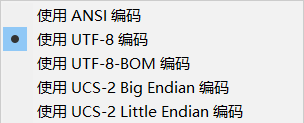常见编码集:
| 字符集 | 说明 |
|---|---|
| ASCII | 英文编码 |
| ISO-8859-1 | Lation-1 拉丁字符,包含中文、日文等 |
| UST-8 | 扩展变长的unicode字符(1-3),国际通用 |
| UTF-16BE | 定长unicode字符(2字节),大端Big-endian表示1 |
| UTF-16LE | 定长unicode字符(2字节),小端little-endian表示2 |
| UTF-16 | 文件中开头指定大端还是小端表示方式,即BOM(Byte-Order-Mark):FE FF 表示大端,FF FE 表示小端 |
Java字符使用16位的双字节存储,但是实际文件存储中有各种字符编码集

字符编码:
package cn.yzy.IO;
import java.io.UnsupportedEncodingException;
/*
* 编码
*/
public class ContentEncode {
public static void main(String[] args) throws UnsupportedEncodingException {
String msgString = "性命生命使命";
//编码:字节数组
byte[] datas = msgString.getBytes(); //不给定参数默认使用工程的字符集
System.out.println(datas.length);
//当前工程的默认是GBK,一个汉字是两个字节
//指定编码方式
datas = msgString.getBytes("UTF-16LE");
System.out.println(datas.length);
datas = msgString.getBytes("GBK");
System.out.println(datas.length);
}
}
以上输出结果都是12,UTF-16LE和GBK编码一个汉字占两个字节
字符解码:
package cn.yzy.IO;
import java.io.UnsupportedEncodingException;
/*
* 解码
*/
public class ContentDecode {
public static void main(String[] args) throws UnsupportedEncodingException {
String msgString = "性命生命使命";
byte[] datas = msgString.getBytes();
//解码
msgString = new String(datas, 0, datas.length, "GBK");
//GBK可以小写也可以大写
System.out.println(msgString);
//乱码的情况:字节不够
msgString = new String(datas, 0, datas.length-1, "GBK");
System.out.println(msgString);
//乱码的情况:字符集不统一
msgString = new String(datas, 0, datas.length, "utf8");
System.out.println(msgString);
}
}
解码用如下String的构造函数
public String(byte bytes[], int offset, int length, String charsetName)
工程的默认编码是GBK因此上述代码使用GBK做测试,解码后能得到原先的文字,证明解码正确性。
注意:乱码的情况出现在字节不够以及字符集不统一的情况下